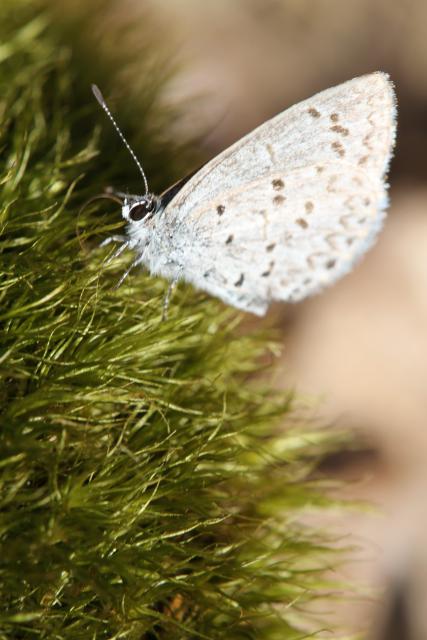Crab Spider (part 3)
ktuli — Mon, 04/19/2010 - 20:26
So we're closing in on the end of the available photos from this crab spider. Towards the end of the shoot, this little guy definitely let me know he was getting tired of me.
That is definitely something you need to be conscientious of when working with any kind of wildlife photography. Your subject will definitely let you know when you need to back off. Ideally, you want to be done with your photos well before that time comes - both for the health of your subject as well as for the natural behavior to be captured in your images.
It is a little tougher to identify those warning signals with small insects and spiders. This is definitely one, though.
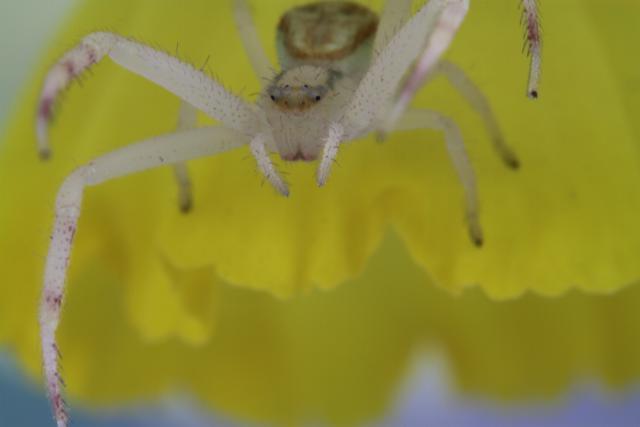
Technical Data: Canon EOS 7D, Tamron 180mm f/3.5 Di SP LD 1:1 Macro with Kenko Teleplus PRO 300 "DG" AF 2x Teleconverter for effective 360mm with 68mm in extension tubes. 1/2 sec at f/9.1 and exposure compensation +1/3 stop. ISO 200. No post production.
Why This Photo: I was just working the subject as much as I could before having to pack it in. At this point, almost any motion caused him to rear up and posture aggressively (earlier in the shoot, it took dramatic motions or very loud noises like my dog barking). At this point, he was charging to the edge of the flower and waving his front limbs around like crazy. I had him framed and set for what I thought would be a great shot, and as I pressed the shutter release and started the timer, he waves his limbs around again, and I just had to get whatever posture he ended up in when the timer ended.
What Works: Focus is sharp, and I like the overall exposure. I like how the edge of the flower was visible in this shot - so many of the shots in this set were so zoomed in that it wasn't always apparent that this was on a flower.
What Doesn't Work: The original framing had all parts of the spider inside the shot, but after he decided to flail about wildly, that wasn't the case for the final shot. I could have not framed the original shot so tightly, but then I would be sacrificing some of the magnification.
One other thing I was going for with this shot was to capture the nice greenish color on the abdomen of the spider. It really was very beautiful. You can catch a hint of it here, but unfortunately, I don't think I did such a good job of capturing that. I didn't manage to get it in any of the photos in this set.
What do you think?
- Bill
Timeout for TED
ktuli — Sun, 04/18/2010 - 20:22
I still have one or two posts from my photo session with that crab spider. However, last week I found a website that I think will end up being a bit of a time-sink, but in a good way.
I am talking about TED.com. Apparently the TED (which stands for Technology, Entertainment, Design) conference has been going on for years, and is some of the best thinkers of our time giving some of the most engaging talks I've ever heard.
The video here is the first one I found - purely by accident - that lead me to view some others on the TED.com website. It sure beats watching some of the other mindless videos out there.
I've always been interested in the way our senses work, in particular sight. That might be why I'm interested in photography - the idea of capturing a frozen image of what I see. But as my last post, even the tiniest changes can have a huge difference in the final photo. This discussion by Beau Lotto about some optical illusions spoke directly to me on multiple levels, but I thought it spoke very loudly to me about some of the challenges we face as photographers in trying to capture that image to show others exactly what we are seeing.
I've watched the video several times at this point, and each time I'm just as impressed with it. I continue to be amazed with the human senses and to feel a little overwhelmed at how daunting at task it actually is to make photographs in such a way that they portray what it was we were seeing through the viewfinder when we took the photo.
I've added the site to my RSS reader, and it looks like I've got a hundred items just there to watch, and I've already seen several topics that I'll probably be reposting here.
Enjoy the video.
Drop me a comment and let me know what you think.
- Bill
Poll: Crab Spider (part 2)
ktuli — Wed, 04/14/2010 - 19:02
If you haven't read part 1 yet, definitely check it out.
I've said this before here, but when you find a subject worth shooting, take your time and work with the subject. I kept over thirty exposures (and took probably twice that many but deleted the completely worthless ones) from a span of over two hours of working with this spider.
Definitely work your subject.
With that in mind, I kept trying different exposure levels. Here are four different exposures - take a look and vote below for your favorite. Despite the great variance in the look of these photos, these are straight out of the camera with no post production.

Version 1: 1/5 sec at f/9.1 with pop-up flash. IMG_0998
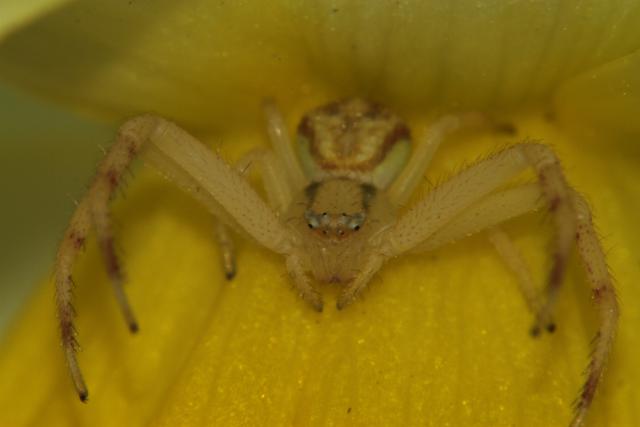
Version 2: 1/10 sec at f/9.1 with pop-up flash and exposure compensation -1 stop. IMG_0999
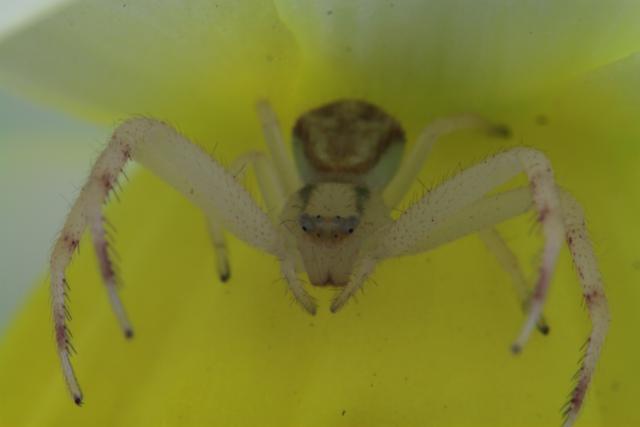
Version 3: 1/3 sec at f/9.1 with no flash and exposure compensation -1/3 stop. IMG_1000
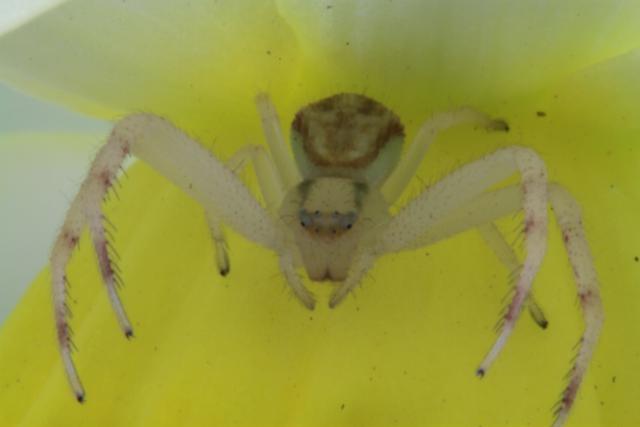
Version 4: 4 sec at f/25.8 with no flash. IMG_1001
Pretty different, huh? If you use tabs in your browser, I recommend opening each image in a different tab (usually control+clicking the link) and switching between the tabs to see the distinct difference between the images (scrolling through them sometimes makes it tougher to compare.
General Technical Data:Canon EOS 7D, Tamron 180mm f/3.5 Di SP LD 1:1 Macro with Kenko Teleplus PRO 300 "DG" AF 2x Teleconverter for effective 360mm with 68mm in extension tubes. ISO 200. No post production.
One of these will definitely be submitted to a couple upcoming contests. I just need to figure out which one I like best.
What do you think? Vote below, and then leave a comment and let me know why you chose the version you did.
- Bill
Crab Spider (part 1)
ktuli — Tue, 04/13/2010 - 20:36
I've seen photos of crab spiders before, and I've always thought they were awesome spiders. When I found one in our own garden, I was amazed. I spent the better portion of the evening photographing it.
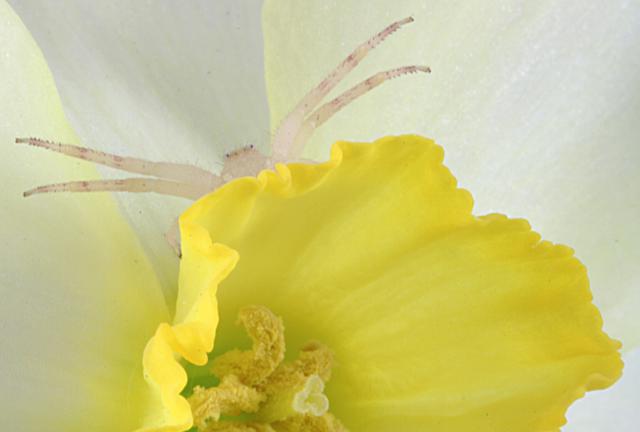
Technical Data: Canon EOS 7D, Tamron 180mm f/3.5 Di SP LD 1:1 Macro with Kenko Teleplus PRO 300 "DG" AF 2x Teleconverter for effective 360mm. 1 second at f/28.1. ISO 200. Post Production: Sharpen 100% 15 pixels, cropped (original).
Why This Photo: This is the first crab spider I've seen, so I took as many photos as I could. It was fairly aggressive and would posture like this whenever loud noises or quick motions happened. I wanted to try and capture that aggressive posturing.
What Works: I did some of the things I've been meaning to try and keep in mind with my macro work. The kind of stuff I did to try and make this photo better include:
- Used a tripod
- Smaller aperture for greater depth of field
- Timer delay (since I still don't have a remote trigger)
- Live View with zoom for better focusing
- Generous framing to allow for cropping if necessary
What Didn't Work: I wasn't thrilled with the framing, but since I left enough room, I was able to crop it down to something I liked more. The image was a bit out of focus, but I was able to sharpen it a little in Photoshop. I keep debating the exposure levels, feeling that the image is a bit blown out, but haven't been able to adjust the levels in Photoshop to my liking - though the cropping removed some of the problem by removing some of the extra areas of white flower pedals.
Working on these photos helped me to feel like I've come along way and have started to put some of the things I've learned into practice. At the same time, they's showed me how much more I have to learn.
What do you think? How did I do with this very special subject to shoot?
- Bill
While We Wait...
ktuli — Mon, 04/12/2010 - 20:47
I have some new photos uploading as I type this. I am so excited about these that I just couldn't bring myself to look through my other older photos to find something else to talk about here.
Today, Anya told me I should go outside and take some photographs of the flowers that are starting to bloom. After a few shots, I decided to move on to the daffodils. I thought I would try for a different angle with a top-down shot.
As I stood over the first daffodil, I focused the lens and was surprised to find a crab spider! Before today, I didn't know that crab spiders were native to this area. I'd often seen photos of them, and always thought they were very cool spiders.
While Anya made me a wonderful dinner of balsamic vinaigrette glazed chicken, I setup the camera and tried to correct a number of the mistakes that I mentioned in yesterday's post. I setup the tripod and used a timer delay (I have yet to purchase a remote trigger for my Canon 7D.
After a while, the sunlight was fading, the breeze picked up and kept moving the flower, and dinner was ready. So I cut the flower and took both it and the spider inside. I then spent the better portion of the evening photographing this tiny little spider. Eventually, I had to put the spider back outside, but I'm extremely happy with the photos I managed to get.
I should be able to share some of them tomorrow. I, for one, can't wait!
- Bill
Moth and Moss
ktuli — Sun, 04/11/2010 - 20:01
Anya and I took another trip out to Deer Lakes Park to see what we could find to shoot. I was mainly looking for more macro photos.
As we walked along, I saw this small bright blue moth fluttering around. I tracked it for a few minutes, then managed to pick it up. This isn't something I do too often, as I try to not impact anything I photograph, but I figured if I could be careful enough to not injure the moth, it would be ok. Maybe this is a technique I can work on improving and using to my advantage.
Once I managed to catch the little guy, he actually seemed very willing to hang out, easily moving from hand to hand if I just put another finger in front of him he would walk up onto it. After looking around for a bit, Anya found a small clump of moss that would work great as a backdrop.
As I held the moth, I noticed his proboscis was scanning over my hand, and I decided I wanted to try and photograph that. Luckily, he continued to search through the moss with his proboscis the same way.
Technical Data: Canon EOS 7D, Tamron 180mm f/3.5 Di SP LD 1:1 Macro, 1/170 sec at f/8. ISO 200. No post production. Deer Lakes Park, Tarentum, PA.
Unfortunately, I didn't do such a great job of getting the shot I wanted. There were a few things I had in mind while taking these photos - some improvements I wanted to make, some things I wanted to try. But at the same time, there where are a couple of things I did wrong, and some things I simply forgot.
- Hand-held Shooting: This is a bad habit that I think I need to break sometime soon. I am not a big fan of the tripod we own (I've been telling myself for a while we need a new one). However, I rarely carry a tripod with me when I head out into the field. I sometimes get away with it, but today was not one of those days.
- Smaller Aperture, Slower Shutter Speed: I've been looking at some of my macro photography, and I'm starting to wish I had used a smaller aperture to capture more depth of field. So today was when I thought to try that. The photo here was shot at f/8. Combine that with my reluctance to carry a tripod, and you increase your chances of blurry photos.
- Poor Framing: This photo is only one out of ten that did not cut off any part of the moth. This is something I'm rather disappointed in myself with. Granted this is something that is easy to do with macro where any movement is exaggerated. But that's really no excuse, I simply wasn't taking the time I should have been to get things lined up.
All in all, I came away with a fairly disappointing set of photos, but some important reminders about things I need to keep in mind when out taking photos. Hopefully next time out, I can work on the juggling act that is remembering all the pieces that need to come together to be able capture that remarkable image.
Have any suggestions for things I could do to improve these photos? Or have any questions about the things I did right or wrong with my shots? Or just want to commiserate about the struggles of macro photography? Leave me a comment and let me know what you think.
- Bill
Aphids on Rosebud
ktuli — Tue, 04/06/2010 - 19:43
I submitted this photo to the Photographic Section's second digital projected image competition of the year.
I really liked this photo. Unfortunately, it didn't do so well in the judging.
Technical Data: Canon EOS Digital Rebel XT, Tamron 180mm f/3.5 Di SP LD 1:1 Macro, 1/250 sec at f/4. ISO 400. No post production. Taken in our backyard.
Why This Photo: I originally was in the yard photographing an insect I had never seen before (but turned out to be a ladybug larva and I'll share some of those photos eventually) when I saw this rosebud covered in aphids. I steadied the lens by leaning against our fence and squeezed off as many photos as I could.
What Works: The focus is tack sharp, and the shallow depth of field produces a perfectly blurred background providing a soft green background. The rose sits on one of the thirds lines with the lean of the rosebud is towards the center of the photo keeping the viewers attention from wandering.
What Doesn't Work: I honestly don't think there is much wrong with this photo. I didn't agree with any of the critiques this photo received at the competition, and since I can't think of any I'll just leave it open.
I did remove the sensor dust spots in the version I submitted for competition. That would be the two dark spots on the left side of the photo. We've since cleaned the sensor on our camera to remove future occurrences of that.
What do you think? Is this photo as strong as I think? Or can you find things you don't like about it?
Leave me a comment and let me know what you think.
- Bill
The Doggies
ktuli — Wed, 03/31/2010 - 20:07
So I keep trying to find the motivation to get back on track here. Well, tonight after work, I took our dogs out to South Park's off-lease dog area. I'll spare you the claims that our dogs are the cutest dogs out there (mainly because everyone usually thinks their dogs are the cutest). But I will say that both of our dogs are rescue dogs. I strongly advocate adopting rescue dogs, and also advocate for mutts (as I'm not usually a big fan of all the pure-bred dogs people spend thousands of dollars on).
So anyway, tonight I guess our doggies can be my motivation.
I usually am not too pleased with the photographic qualities of the shots I take of our dogs. But I keep trying. One of these days I'll get it right. But I guess the important part is to keep trying.
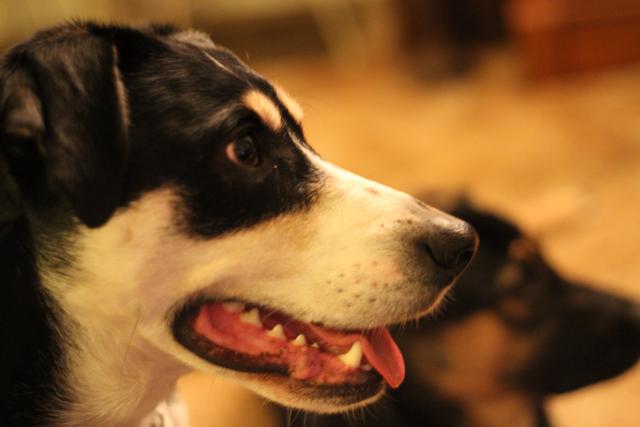
Technical Data: Canon EOS 7D, Canon EF 50mm f/1.8 II, 1/32 sec at f/1.8, ISO Auto. No Post Production.
Why This Photo: I had just received my new 50mm f/1.8 lens (a great budget lens for $99!) and wanted to play around with it. I was sitting on the floor with the dogs, and figured I'd try for that elusive good pet photograph.
What Works: The soft background is about the only good thing about this photo. That is a product of that large f/1.8 aperture.
What Doesn't Work: Just about everything else. Focus is a little soft. There is a bad yellowish tinge to the photo. There is a convergence of the dogs' heads. And there are some distracting elements in the top right corner of the photo.
So yeah - not the greatest photo ever. But it is a learning tool. I definitely think unless you're incredibly lucky, you'll take plenty of bad photos before you take a majority of good photos.
The key is to remember to stick with it and learn from your mistakes. Which is what I try to do by keeping those less than stellar photos around, and revisiting them from time to time.
Drop me a line and let me know what you think.
- Bill
Gift Idea
ktuli — Mon, 03/29/2010 - 21:23
Yeah - I know - I've been slacking and haven't posted for a while. I promise I'm working on getting out of the funk I'm in. I will be posting soon.

In the meantime, I know my birthday and Christmas are just barely passed, but if you're looking for a gift to get me, here it is!
A travel thermos mug that looks like a Canon 70-200mm L series lens.
If only I had somehow started into photography at a much younger age, and been a professional photo-journalist that got to go to the 2010 Winter Olympics in Vancouver, I would have one of these for free.
Instead, I have to wait around till mid-April supposedly, and then it looks like pay about $60 for mine.
But it does look awesome.
And I *need* one.
Wonder if they include the tripod mount so you can have a handle...
- Bill
Quick Hint
ktuli — Wed, 03/17/2010 - 19:46
So this is a quick post tonight. Sitting around watching a Pens game tonight, and looking forward to my own hockey clinic that starts tomorrow evening!
Anyway, this is a quick little reminder for something to pay attention to if you use an SLR. Mainly because this recently happened to me and it took me a few photos to catch it and fix.
I'm talking about making sure that your viewfinder is in focus.
If you overlook this, none of your photos will be as sharp as they should be.
Before writing this up, I decided to do a quick search online to see what others said. I found multiple websites that recommend you get the camera to autofocus on a subject, then adjust your viewfinder with the diopter adjustment knob. If you dig out your camera's manual, you'll find that this is indeed wrong.
You actually want to focus on the elements inside your viewfinder window - the AF points, grid lines, whatever data your SLR provides in the viewfinder window. You are supposed to do this while completely ignoring anything in the field of view through your lens.
To make this easier, I actually do the opposite of the various sites I found suggested. I intentionally defocus the lens to cause a completely blurred image through the lens. That allows me to focus on those AF points and grid lines so much better - particularly if you can find a fairly light background to blur.
Keep this in mind next time you pick up your camera. Give your viewfinder a quick check to make sure it is in focus before you start taking photos. Sometimes it gets bumped putting the camera in your bag - which I assume is why mine was out of focus that day not too long ago.
By the way, if you're totally confused as to what I'm talking about, take a look to see if there is an adjustment knob near your viewfinder with a +/- label - that should be the diopter adjustment knob for your viewfinder. Try my suggestion about defocusing the lens and see if your viewfinder is focused. If all else fails, refer to your camera's manual.
- Bill

